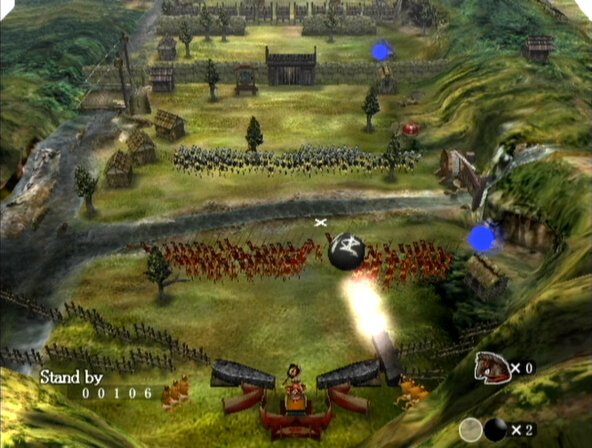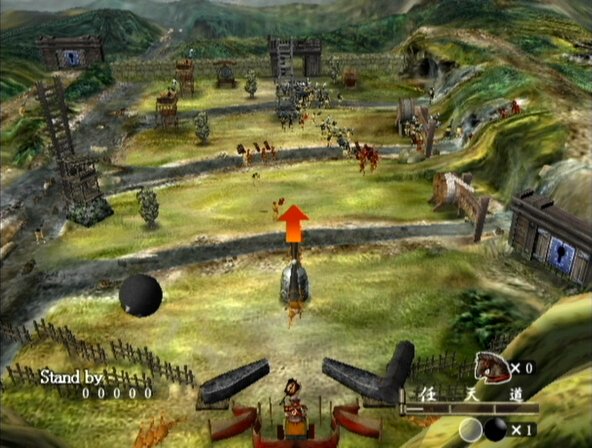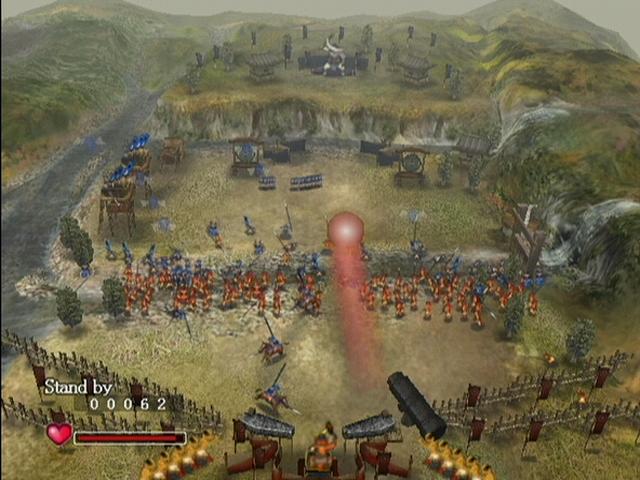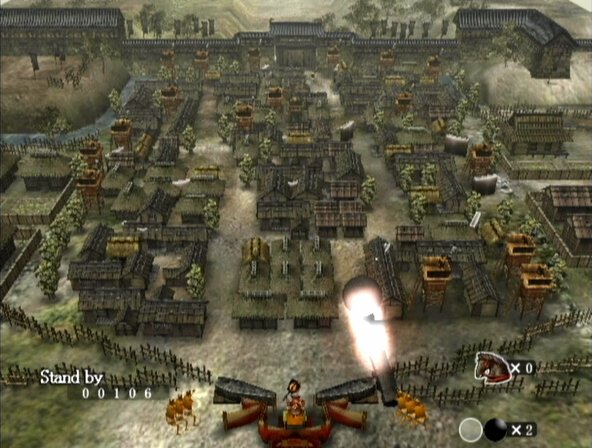Yoot Saito's Odama Update
We check in on one of the most unique titles headed for the GameCube library.
It's been quite some time since Odama first appeared on the horizon for the GameCube. The unique title, a "you need to see it to believe it" mix of pinball and feudal Japanese history, first caught our eye in 2004, when it was shown in embryonic form on the E3 show floor. However, the game's promising first impression was just the tip of the iceberg, as evidenced by its showing at this year's E3, where more of the game, including its voice-recognition feature, was unveiled. We got a closer look at the game at Nintendo's recent press event to see how development is going as its early-2006 release closes in, and are pleased to report the game is shaping up nicely.

If you look behind Odama's quirky presentation, you'll actually find a story to frame the original title's pinball-based mechanics. You'll be cast in the role of Kagetora Yamanouchi, the exiled son of a great lord who was betrayed by his friends and killed, which has resulted in Kagetora's current situation. With his father murdered, Kagetora is cast out with the only two treasures left, the few followers loyal to his family and the odama, a large quasi-mystical metal ball. Your goal is to reclaim what was taken from your father and restore the family name. (Hardcore Nintendo otaku will recognize that "Yamanouchi" is an alternate spelling of "Yamauchi," the name of the Japanese company's founder.) To do this, you'll march into the heart of your lost kingdom with your crew and your large metal ball. It's a tough and complicated matter, but thankfully you're helped by a family friend, who will serve as your advisor, as well as the philosophy of the Neenten-doh, which espouses that you sacrifice your needs for the good of your followers.
The game's story translates, for all intents and purposes, into a unique variation of pinball. You lead your men to victory by offering direction, flinging the family ball every which way on the battlefield, and getting your forces to advance. Your ultimate goal is to figure out how to get a group of your boys to carry a large bell to a gate, which is typically well-guarded, at the top of the screen. Each level will begin with an overview of the land, along with some helpful info from your advisor. To help maintain the game's atmosphere, Nintendo is opting to keep the Japanese voice--a rarity in a Nintendo game--and use subtitles. This ends up adding quite a bit to the odd atmosphere of the gameworld, which all works somehow. It also lets the game's localizers have a good deal of fun with the subtitles. While your advisor's hints are presented in a suitably dry fashion, the chatter from your troops can range from standard cries of "Yes, my lord" to much goofier fare, such as "Oww, burny!" when they catch fire, or not-so-subtle digs at your authority when they begin to lose faith in you. While it likely sounds a little weird, it's also amusing, and more than a little funny.

As far as the meat and potatoes of the gameplay goes, Odama is its own unique animal when it comes to its mechanics. The core mechanics are basically pinball. You'll use the left and right triggers on the GameCube controller to manipulate the "flippers" you'll find in each level. The number of flippers will vary per level; though you'll always have one set at the bottom, the larger levels will feature a second set. The analog control stick will let you tilt the entire landscape to a degree when needed. The Z button will let you deploy men. The D pad will let you target different objects and locations on the map that you can send your troops to. The A button will let you fling out rice balls that you can use to feed your men or distract enemy forces.
Finally, the X button lets you use the GameCube microphone to unleash the power of your voice to issue commands to your men. Though this aspect of the game was initially a bit awkward the last few times we played the game, Nintendo has pulled through; they've made a special clip for the GC controller that's designed to snap on the top of it, to keep your GC mic close without having to juggle your controller. The twist to the voice commands is that you'll earn them as you go, by finding them (along with other power-ups) when you smash objects, such as buildings, on the board. You'll find a total of 11 voice commands to get your troops in gear. We were able to get a peek at a menu you can call up to review your commands, although the version of the game we played only had nine open: advance, march right, march left, fall back, rally, flood the river, close the gate, charge press forward, and company halt.

The pinball aspect of the game is fleshed out with power-ups and effects that will come in handy when you're being mobbed. So, as we mentioned, according to the story, you're traveling with a modest number of supporters. Now, as everyone knows, you can't make an omelet without breaking a few eggs. And your loyal supporters? Eggs. Every one of them. Your crew, obviously, is fiercely loyal to you and heeds your orders without question...for a while, anyway. As anyone who's commanded legions of troops knows, loyalty and morale are tricky things, especially when you accidentally squash a few dozen of them with a large ball on the field of battle. So we'll just tell you now that you shouldn't grow attached to any one of your troops, because odds are you will moosh them at some point, whether by accident or necessity. While this complicates matters, because you'll run through your stock of men quickly if you're not careful, you'll have some options. The first is to make use of the bell your men are carrying. Hitting the bell with the odama causes a shock wave that knocks anyone around it to the ground. If you manage to have the bell charged when you hit it, your odama will be charged up with mystical energy that will keep it from harming your troops, while also absorbing any enemy troops it rolls over and adding them to your stock of men. Barring that, over the course of a level you'll also find men whom you can add to your armies. Moreover, you'll be able to save men by distracting the forces of evil with delicious rice balls.
The visuals in the game are about what you would expect from a pinball-style game set in feudal Japan--a genre we expect countless gamers are well versed in. You'll watch the action play out from a top-down view that gives you a sense of the land you'll be working on. Most of the locales we saw were varied, though all were set outdoors, with the exception of the scrolling level, which was set in a large town. You'll see a fair amount of detail in the environments, many of which are interactive; you'll be plowing through a fair amount of trees while attempting to make the best use of your odama. The mystical ball looks as good as a giant ball of metal can hope to. Your followers and enemy forces look fine from afar; they're pretty much ant-size during gameplay, and look on the scrawny side during the in-game cinematics that zoom in close. You'll also see a smattering of understated special effects when you pick up power-ups for the odama. From a performance standpoint, Odama runs fine on the Cube. The work-in-progress version of the game we tried ran smoothly despite the onscreen action, which can get more than a little hectic.

Based on what we played, Odama is a quirky, downright adventurous title for the GameCube library that we're happy to see on the horizon. The unique game is shaping up to be a funky offering that should keep the GameCube's final year interesting. The gameplay mechanics are accessible and the story, though a little random, works, thanks to a bizarre, wry sense of humor. Though the GameCube's 2006 lineup won't be chock-full of games, Odama appears as though it will be a quality title worth your time. Look for more on the game in the coming months.
Got a news tip or want to contact us directly? Email news@gamespot.com
Join the conversation